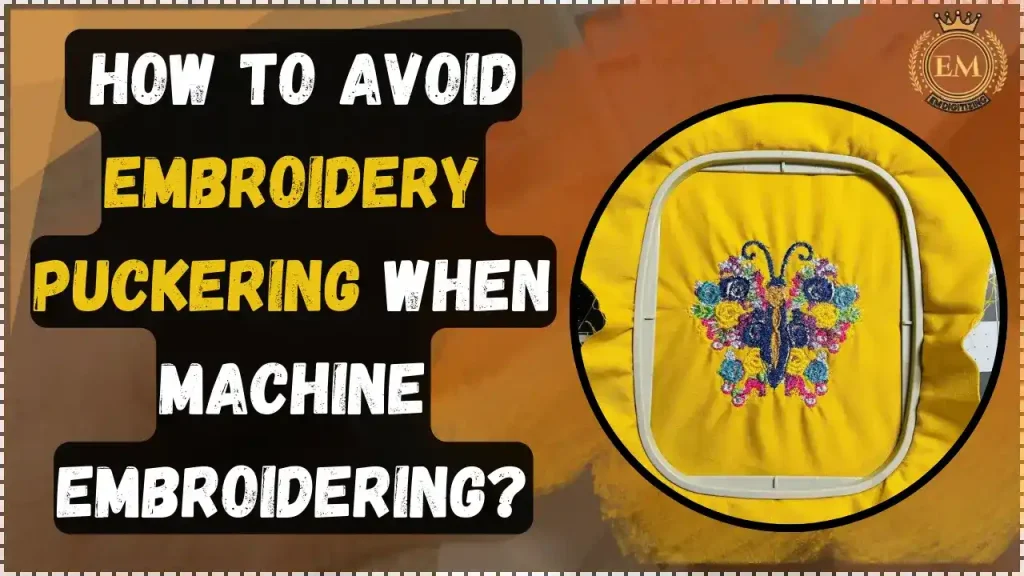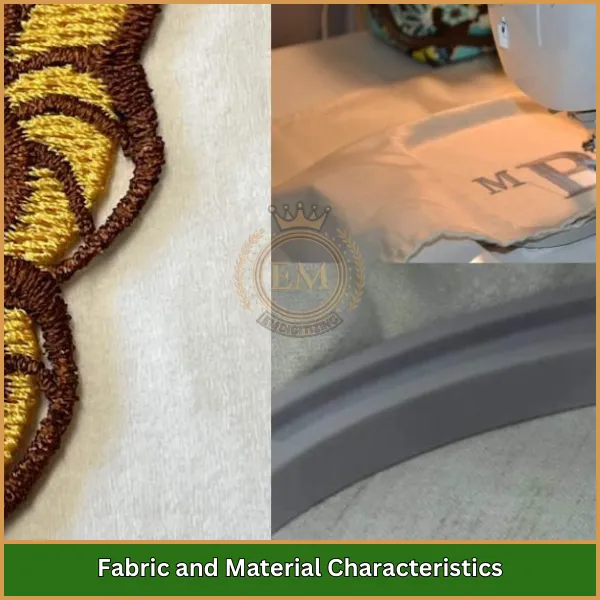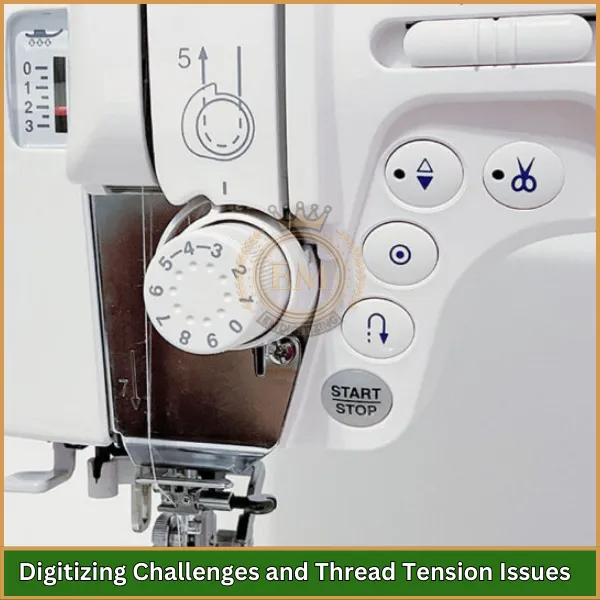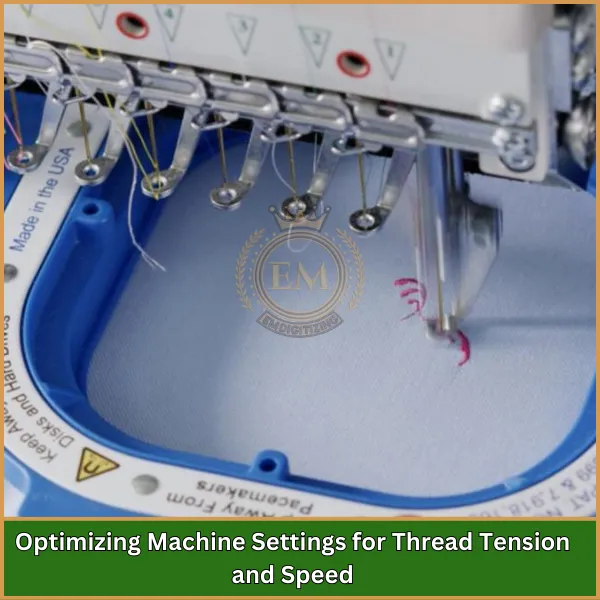Are you tired of dealing with embroidery puckering when you’;Sie arbeiten gerade an Ihren Maschinenstickprojekten?
Es kann frustrierend sein, zu sehen, wie all Ihre harte Arbeit durch Falten im Stoff zunichte gemacht wird. But don’;Keine Sorge! I’;Ich bin hier, um Ihnen zu helfen, zu verstehen, warum Falten auftreten und wie Sie sie verhindern können.

Am Ende dieses Leitfadens, you’;Sie erhalten das Wissen und die Tipps, die Sie benötigen, damit Ihre Stickerei jedes Mal reibungslos und professionell aussieht.
Let’;Lasst uns eintauchen und diese gemeinsame Stickherausforderung gemeinsam angehen!
So vermeiden Sie Faltenbildung beim Maschinensticken?
Das Kräuseln von Stickereien verstehen
Beim Sticken kommt es zu Kräuselungen, wenn sich der Stoff rund um die Stiche zusammenzieht oder Falten wirft, Dadurch sieht Ihr Design holprig oder uneben aus. It’;Es ist, als würde man eine Tischdecke herausziehen, und Teile davon sammeln sich; something similar happens with fabric when you’;neu sticken.
Dieses Problem kann dazu führen, dass Ihre schöne Stickerei weniger ordentlich und professionell aussieht.
Warum kommt es zu Kräuseln??
Puckering usually happens because the fabric moves around too much when you’;Sticken Sie es noch einmal.
If the fabric isn’;t held tightly enough or if it’;Es ist eine Art, die leicht gleitet, es kann sich unter der Nadel zusammenballen.
Imagine trying to write on a piece of paper that keeps slipping away—it’;Es ist schwer, ordentlich zu schreiben, Rechts? It’;Dasselbe gilt auch für Stickereien.
Arten von Stoffen, die sich kräuseln könnten
- Rutschige Stoffe: Materialien wie Satin oder Nylon sind glatt und lassen sich leicht gleiten, Das macht es schwierig, sie zu sticken, ohne Falten zu werfen.
- Leichte Stoffe: Dünne Materialien, wie Leinen oder etwas Baumwolle, können auch leicht knittern, da sie nicht sehr schwer sind.
- Dehnbare Stoffe: Stoffe, die sich dehnen, wie sie in T-Shirts verwendet werden, kann sich beim Sticken verformen, vor allem, wenn sie nach dem Lösen wieder in Form kommen Stickrahmen.
Häufige Ursachen für Faltenbildung in der Stickerei
Kräuselungen können das glatte Aussehen Ihrer Stickerei beeinträchtigen, Daher ist es wichtig zu verstehen, was die Ursache dafür ist. Hier erfahren Sie im Detail, warum das passiert und wie Sie die üblichen Verdächtigen erkennen können, die zu Faltenbildung führen.
- Stoff- und Materialeigenschaften
- Fehlausrichtung des Stabilisators und Auswahlfehler
- Digitalisierungsherausforderungen und Fadenspannungsprobleme
Stoff- und Materialeigenschaften

Das Art des Gewebes Die von Ihnen verwendete Flüssigkeit spielt eine große Rolle dabei, wie wahrscheinlich es ist, dass sich Falten bilden. Some fabrics just don’;t handle embroidery well because they’;Entweder sind sie zu dehnbar, zu dünn, oder zu rutschig.
Zum Beispiel, if you’;Ich arbeite mit einem rutschigen Stoff wie Satin, es kann sich unter der Nadel zu stark bewegen. Ähnlich, Leichte Stoffe wie Chiffon können sich verziehen, weil sie der Spannung nicht gut standhalten.
Jeder Stofftyp hat seine eigenen Bedürfnisse, Daher ist die Wahl des richtigen Sticks für Ihr Projekt von entscheidender Bedeutung für die Aufrechterhaltung der Stickqualität.
Fehlausrichtung des Stabilisators und Auswahlfehler

Ein Stabilisator unterstützt Ihren Stoff beim Sticken, hilft, es flach und an Ort und Stelle zu halten. Wenn der Stabilisator nicht richtig ausgewählt oder ausgerichtet ist, Ihr Stoff könnte sich beim Sticken bewegen oder dehnen. Diese Fehlausrichtung kann dazu führen, dass sich der Stoff zusammenzieht, was zu Faltenbildung führt.
Es ist, als würde man das falsche Fundament unter ein Haus legen; wenn es nicht stimmt, Es kann schief gehen.
Die Auswahl des richtigen Stabilisators für Ihren Stoff und die Sicherstellung, dass er richtig aufgetragen wird, sind wichtige Schritte, um Faltenbildung bei Maschinenstickereien zu verhindern.
Digitalisierungsherausforderungen und Fadenspannungsprobleme

Die Art und Weise, wie du Stickerei-Design Die in der Digitalisierungssoftware erzeugten Bilder können ebenfalls zu Faltenbildung führen. Wenn das Design zu dicht ist oder der Stickpfad nicht für Ihren Stofftyp optimiert ist, Der Stoff kann beim Sticken zu stark gespannt werden.
Diese Spannung des Fadens beim Durchziehen des Stoffes kann zu Kräuselungen führen. Es ist wichtig, dass Sie Ihr Design unter Berücksichtigung des spezifischen Stoffes digitalisieren, unter Berücksichtigung von Faktoren wie Stichlänge und -dichte.
Umfassende Lösungen zur Verhinderung von Faltenbildung in der Stickerei
Um glatte und professionell aussehende Stickdesigns zu erzielen, Es ist von entscheidender Bedeutung, wirksame Strategien zu implementieren, die häufige Ursachen für Faltenbildung bekämpfen.
Hier finden Sie eine Anleitung zu den umfassenden Lösungen, die Ihnen helfen können, dieses Problem zu verhindern
- Auswahl des geeigneten Stabilisators
- Richtige Stoff- und Rahmenvorbereitungstechniken
- Erweiterte Digitalisierungstipps zum Reduzieren der Dichte und Anpassen der Unterlage
- Optimieren der Maschineneinstellungen für Fadenspannung und Geschwindigkeit
Auswahl des geeigneten Stabilisators
Der richtige Stabilisator bildet das Rückgrat einer erfolgreichen Stickerei, indem er den Stoff während des Stickvorgangs stützt. Es ist wichtig, ein Vlies zu wählen, das dem Gewicht und der Dehnbarkeit Ihres Stoffes entspricht.
Zum Beispiel, use a cut-away stabilizer for stretchy materials to prevent the fabric from moving and a tear-away for more stable fabrics that don’;nicht dehnen. Dadurch bleibt der Stoff glatt und gestützt, Minimierung der Wahrscheinlichkeit einer Faltenbildung.
Richtige Stoff- und Rahmenvorbereitungstechniken

Wenn Sie Ihren Stoff vor Beginn richtig vorbereiten, kann das Risiko von Kräuselungen erheblich verringert werden. Zuerst, Stellen Sie sicher, dass der Stoff ordnungsgemäß gebügelt und faltenfrei ist. Beim Reifen, Der Stoff sollte straff, aber nicht überdehnt sein.
It’;Es ist wie Trommelfell; Es sollte fest genug sein, dass es bei leichtem Antippen zurückspringt. Dieses Gleichgewicht trägt dazu bei, während des gesamten Stickvorgangs eine gleichmäßige Spannung aufrechtzuerhalten, verhindert, dass sich der Stoff um die Nähte herum sammelt.
Erweiterte Digitalisierungstipps zum Reduzieren der Dichte und Anpassen der Unterlage

Die Art und Weise, wie eine Stickdatei digitalisiert wird, kann das Endergebnis erheblich beeinflussen. Um ein Falten zu vermeiden, Reduzieren Sie die Stichdichte in Ihrem Design, insbesondere bei der Arbeit mit leichten oder empfindlichen Stoffen. Zusätzlich, Eine Anpassung der Unterlage kann zur Stabilisierung des Materials beitragen.
Als Fundament dient eine Unterlage, Halten Sie den Stoff fest und glätten Sie ihn, bevor Sie die Oberstiche anbringen. Durch die richtige Einstellung der Unterlage kann verhindert werden, dass der Stoff durch die Stiche zu stark gespannt wird.
Optimieren der Maschineneinstellungen für Fadenspannung und -geschwindigkeit

Die Anpassung der Einstellungen Ihrer Stickmaschine ist entscheidend, um Kräuselungen vorzubeugen. Die Fadenspannung sollte so eingestellt werden, dass sie weder zu fest noch zu locker ist; Beide Extreme können dazu führen, dass sich der Stoff kräuselt. Ebenfalls, Erwägen Sie, die Geschwindigkeit der Stickmaschine zu reduzieren.
Eine langsamere Geschwindigkeit ermöglicht eine präzisere Stichplatzierung und verringert die Belastung des Stoffes, Dies kann dazu beitragen, die Qualität der Stickerei zu erhalten und Faltenbildung zu verhindern.
Fazit: Gewährleistung reibungsloser und professioneller Stickergebnisse
We’;Wir haben darüber gesprochen, wie Sie das Kräuseln der Stickerei verhindern und dafür sorgen können, dass Ihre Stickprojekte sieht ordentlich und glatt aus. Erinnern, um die besten Ergebnisse zu erzielen, Sie müssen die richtige Unterlage verwenden, Stellen Sie sicher, dass Ihr Stoff genau richtig in den Rahmen eingelegt ist, und stellen Sie Ihre Stickmaschine richtig ein.
If you’;Sie suchen fachkundige Hilfe, um das Beste aus Ihren Stickdesigns herauszuholen, unser Digitalisierung von Dienstleistungen bei EMdigitalisieren sind hier, um Ihnen zu helfen. Wir bieten schnelle Bearbeitungszeiten, erschwingliche Preise, und hochwertige Ergebnisse, die Ihre Stickprojekte aufwerten.
Plus, if it’;Sie nutzen unsere Dienste zum ersten Mal, du bekommst 50% aus! Dies ist eine großartige Gelegenheit zu sehen, wie professionelle Hilfe Ihre Designs jedes Mal perfekt zur Geltung bringen kann.
So, Machen Sie sich keine Sorgen mehr über Falten – wir helfen Ihnen dabei, jedes Projekt zum Erfolg zu führen!
Häufig gestellte Fragen
Embroidery can pucker after being washed if there’;Es ist zu viel Spannung beim Nähen oder es wurde nicht genügend Vlies verwendet. Wenn Sie es waschen, the fabric might change shape because it wasn’;Es wird während des Stickvorgangs nicht richtig unterstützt.
Zum Glätten von Falten in der Stickerei, Beginnen Sie damit, das bestickte Objekt mit der Vorderseite nach unten auf eine ebene Fläche zu legen. Besprühen Sie es leicht mit Wasser. Dann, Dehnen Sie den Stoff vorsichtig, bis er flach liegt. Diese Methode hilft, die Fasern zu entspannen und Faltenbildung zu reduzieren.
Faltenbildung in der Stickerei kann aus mehreren Gründen auftreten, Dazu gehört auch, dass der Stoff nicht richtig eingespannt wurde, nicht genügend Stabilisator verwenden, schlechte Digitalisierung, oder die Fadenspannung ist zu hoch. Häufig, Falten werden auch durch verursacht Entwürfe die zu dicht sind oder zu viele Stiche auf kleinem Raum haben, was den Stoff stark beansprucht.
